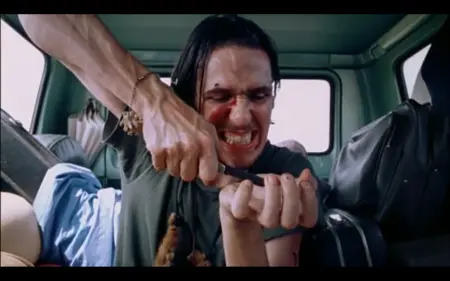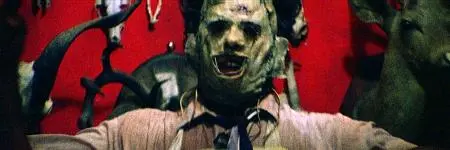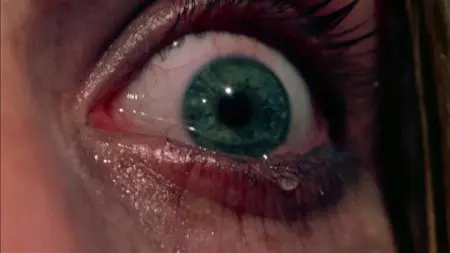Welcome back to What Works & What Doesn't. In the previous two installments, we discussed "The Story Triangle" as outlined by Robert McKee in his fantastic screenwriting book Story: Substance, Structure, Style, and the Principles of Screenwriting. First we explored the tenets of a Classical Design or Archplot via Robert Towne's classic Chinatown; next, we examined Minimalism or Miniplot by analyzing Sofia Coppola's wonderful Lost in Translation. Now, to cap off this discussion with the third and final point on McKee's triangle—Anti-Structure or Antiplot—let's load up the van and take a freewheeling road trip.
Where are we going? To Texas, of course. Rural Texas, to be exact.
I can think of no better film that both exemplifies and actively subverts McKee's notion of Antiplot than Tobe Hooper and Kim Henkel's seminal horror masterpiece The Texas Chainsaw Massacre. It is, quite simply, structured cinematic anarchy of the highest order, more an experience in vicarious terror than a traditional piece of narrative fiction. So without further ado, let's breakdown TCM's triumphs, and see if there are any elements that miss the mark.
WHAT WORKS
Constructing a Façade
McKee defines Antiplot as such:
Antiplot...[is] the cinematic counterpart to the antinovel or Nouveau Roman and Theatre of the Absurd. This set of antistructure variations doesn't reduce the classical but reverses it, contradicting traditional forms to exploit, perhaps ridicule the very idea of formal principles.
Films of this nature are characterized by these three signifiers: Coincidence, Nonlinear Time, and Inconsistent Realities. Now, TCM isn't exactly ruled by all of these qualities, but that's okay: even McKee acknowledges that his triangle is useful only in an academic sense, and that movies rarely "settle at its extreme corners," but rather "writers slide their stories along these lines, blending or borrowing from each extreme."
We'll break down just how TCM both falls in line and breaks away from the tenets of Antiplot in a moment, but first, for the sake of clarity, let's look at the characteristics of the other two extremes, Archplot and Miniplot.
CLASSICAL DESIGN / Archplot (Chinatown)
Causality
Closed ending
Linear Time
External Conflict
Single Protagonist
Consistent Reality
Active Protagonist
MINIMALISM / Miniplot (Lost in Translation)
Open Ending
Internal Conflict
Multi-Protagonists
Passive Protagonist
ANTISTRUCTURE / Antiplot (The Texas Chainsaw Massacre)
Coincidence
Nonlinear Time
Inconsistent Realities
Coincidence vs. Causality: Let's once again turn to McKee himself to define these supposedly mutually exclusive terms.
CAUSALITY drives a story in which motivated actions cause effects that in turn become the causes of yet other effects, thereby interlinking the various levels of conflict in a chain reaction of episodes to the Story Climax, expressing the interconnectedness of reality.
COINCIDENCE drives a fictional world in which unmotivated actions trigger events that do not cause further effects, and therefore fragment the story into divergent episodes and an open ending, expressing the disconnectedness of existence.
Where TCM is concerned, we easily see a blend of both causality and coincidence fueling the narrative along. The plot is threadbare at best—five teens travel to rural Texas after reports of grave robbing and desecration in a local cemetery. Our protagonist Sally and her infinitely annoying brother Franklin want to check on their grandfather's final resting place to ensure it hasn't been violated, and also to visit their grandparents' old farmhouse. Along for the ride are Jerry, Sally's boyfriend, and another couple, Kirk and Pam.
The group of friends make the mistake of picking up a crazed hitchhiker, who may or may not mark the van as a potential target for the other members of his cannibal family. And that's about as far as it goes where causality is concerned, if we compare the chain of events to the Classical Design or Archplot mode of storytelling, in which characters pursue specific goals and either gain or lose traction and distance while engaged in said pursuit (Chinatown—Gittes investigates Hollis's disappearance, then the Water Department, and so on, further miring himself in the mystery). For Sally and her gang, coincidence dominates everything that happens following their brief encounter with the hitchhiker. They just happen to be at the wrong place at the wrong time.
Nonlinear Time: Upon first glance, it would seem that TCM follows a traditional A-Z timeline, and this assessment would be correct—for the most part. No, we don't jump around in time with flashbacks and flash-forwards here, but time isn't so concrete or fixed either. To best explain this "wibbly-wobbliness," we need to jump ahead to the next Antiplot signifier.
Inconsistent Realities: As indicated above, the world of TCM is skewed from the film's onset. The very first "scene" if you will is a strange, monotone opening narration (by John Larroquette) accompanied by scrolling text, both of which claim the proceeding narrative is based on a true story, giving the whole experience, at least initially, an air of police procedural-authenticity. We next see a series of images depicting close-ups of body parts in putrescent decay. These pictures are accompanied by the whine of a flash bulb, a person breathing low under their breath, and unidentifiable scraping, earthy noises, indicating that we are seated in the point-of-view of the aforementioned grave desecrator—an unsettling juxtaposition of sound and image, to be sure, but one still in line with this veneer of authenticity. To cap off this conceit before the title credits roll, we see finally the end result of the desecrator's actions, a grotesque sculpture built from two corpses and placed atop a tombstone; over this image, we hear a news report that talks about various current events and also information about the desecrations that are still ongoing.
It is clear writers Hooper and Henkel want the audience to believe (or at least allow ourselves to be fooled into believing) that the ghastly and horrific events depicted in TCM are real. And yet, the title credits sequence, while continuing the false news report, also mixes in jangling, arrhythmic music laid over highly-saturated, abstract experiments with light and shadow. Thus, this pre-credits sequence (including the narration and the desecrator's photography) juxtaposed with the subsequent title sequence, effectively communicate the filmmakers' true intentions...
Deconstructing the Façade
Immediately following the title credits, the music fades from the soundtrack, but the news report continues on. The first shot we see is of a dead armadillo, which appears to be a very real example of roadkill. Shortly after, we meet Sally, her brother and her friends, though it cannot be said we really get to know them, particularly our protagonist, who is really nothing more than an All-American blonde girl. She seems sweet and intelligent enough, but she is the least fleshed-out character in the van, potentially nothing more than eye candy for the presumably male-dominated audience. But this sexuality pales in comparison, I think, to Sally's role as a blank canvas or a vessel by which we, the audience, gain access to the nightmare to come.
And just like any nightmare (or dream, for that matter), when matters aren't downright horrifying, they're still off-kilter: the thoroughly soused man inexplicably lying in an old tire at the graveyard, mumbling that he "sees things," but that no one listens to him; the violent and destructive unpredictability of the Hitchhiker in the group's van, cutting himself and lighting photographs on fire; the silent man at the gas station who only approaches with his bucket and rag to clean the windshield whenever the Old Man also approaches the van; the strange placement of feathers and bones outside Sally and Franklin's grandparents' house; the "graveyard" of cars near the cannibalistic family's home. All these elements combined work to undermine the normalcy of this otherwise recognizable world, as well as ratchet up tension and suspense until the moment Kirk enters the house upon hearing what sounds like a pig inside and comes face to face with Leatherface, his visage, a leathery mask made of real human flesh, inherently disturbing, his sledgehammer blow to Kirk's head deft and (almost) instantly fatal.
With this single crack to the skull, recognizable reality dissipates, and the nightmare truly begins. As the film progresses toward its climax, logical causality flies out the window. This breakdown is best exemplified by the scene directly following Leatherface's second appearance in the film. First, the bulky, lumbering killer appears in the woods out of nowhere, without making a sound, his chainsaw primed and ready (without pulling its starter cord or revving its engine in anyway). He dispatches Franklin (thank God) then goes after Sally. After an extended chase throughout the family house, during which Sally leaps through a closed second-story window, it seems Leatherface might finally catch up to our All-American, screaming-for-her-life protagonist. She manages, however, to dart into the gas station seen earlier. She collapses into the arms of the Old Man, panting and begging for help, insisting there is a crazy man with a chainsaw behind her. But there's no one there. Leatherface's weapon of choice has been silenced. It's as if he was never there at all, an apparition sprung from the darkest places of the subconscious.
Of course, we learn quickly that Leatherface is indeed all-too real, and that the Old Man is one of "them" (i.e., a bad person, a killer, whose jabbing of Sally with a broom handle while alternately cackling deviously and soothing the girl with a calm dulcet voice is far more unsettling than even Leatherface). However, this still doesn't explain why Leatherface just gives up the chase. But to attempt to make sense of this moment, or the killer's surprise appearance in the woods, undermines the film's mission to unnerve its audience through nightmare logic, which is obviously quite separate from the logic we recognize in the waking world. Again, this is why Sally and her friends aren't richly developed characters—not because they don't matter and are mere fodder for displays of gore effects (as TCM's many imitators assumed), nor because they are awful people who incite a wicked bloodlust in the audience (see again the imitators), but because they are mere avatars through which the audience participates in the nightmare.
McKee mentioned the Theatre of the Absurd above, but I see Hooper and Henkel's designs as inspired more by Antonin Artaud's Theatre of Cruelty than anything else. From Wikipedia (which quotes Nathan Gorelick's "Life in Excess: Insurrection and Expenditure in Antonin Artaud's Theatre of Cruelty"):
The Theatre of Cruelty can be seen as a break with traditional Western theatre, and a means by which artists assault the senses of the audience, and allow them to feel the unexpressed emotions of the subconscious...
...For Artaud, theatre does not merely refer to a staged performance before a passive audience. The theatre is a practice, which 'wakes us up. Nerves and heart,' and through which we experience, 'immediate violent action,' that 'inspires us with the fiery magnetism of its images and acts upon us like a spiritual therapeutics whose touch can never be forgotten.'
While the definition of cruelty in the context of Artaud's theory does not necessarily indicate acts of harshness or indifference, Hooper and Henkel's exploration into bald-faced fear certainly "wakes up" the "nerves and heart" via an assault of the senses. Its constant leaps in logic that defy but ultimately do not entirely invert reality, combined with gruesome imagery and Sally screaming for what feels like an eternity, combined with the labyrinthine madness of the cannibal family, plummets our protagonist (and thus the audience as well) straight into the bowels of insanity. Sure, Sally gets away from Leatherface and hitches a ride in the back of a pick-up truck, but as she speeds away from her would-be killer, she laughs with gleeful abandon, her eyes wide and wild, her face spattered and streaked with blood. Similarly, Leatherface performs an unfettered, temper-tantrum chainsaw dance against the backdrop of a rising sun—the last shot of the film. In essence, Sally and the audience are driven to madness...and left there, with no definitive sense of resolution or catharsis.
WHAT DOESN'T WORK
To speak about "What Doesn't Work" in the context of something like The Chainsaw Massacre is an exercise in judging a film based on the traditional rules of narrative structure. By this I mean that TCM belongs in many ways to a category of storytelling all its own—i.e., it isn't really a story at all, and certainly not one that fits into McKee's story triangle parameters even in a loose sense. It's somewhat subjective to causality and coincidence, but mostly it is driven by the surreal. It eschews plot in favor of seating the audience directly into the terror. You don't really watch TCM so much as nervously crawl your way through it like a carnival spook house ride.
In this way, it can be argued that, as a piece of narrative fiction, the film fails. It categorically does not turn up in intellectual conversations about screenwriting or filmmaking. McKee certainly makes no mention of TCM as an example of Antistructure or Antiplot (nor anywhere else in his book, for that matter), listing instead mostly European art films as relevant titles of study. This list includes Un Chien Andalou, the surrealist film from Luis Buñuel and Salvador Dalí, which features even less of a plot than TCM, also emphasizes audience discomfort through sensory assault, and is famous for its point-of-view shot of an eyeball being sliced open. I see more commonality than dissonance here, quite frankly.
So, to put it simply, the answer to the question "What doesn't work" is: nothing. Hooper and Henkel's primary goal is to unnerve by upending logic and reality, and so nothing ostensibly lazy or nonsensical in the film (like characters going into strange houses despite every indication—and even warnings—against doing so) are in fact plot movements that work. This cannot be said of TCM's imitators, whose characters go into the places they shouldn't because they're unlikable idiots who deserve to die, leaving the audience bored by their "horror movie logic" predictability, rather than genuinely plagued by a nightmare from which, we later find, we cannot escape.
What say you, LitReactor folk? Do you see The Texas Chainsaw Massacre as a flawless experiment in cinematic cruelty (like I do), or is it just another screamfest for you? Let us know what you think in the comments section below.

About the author
Christopher Shultz writes plays and fiction. His works have appeared at The Inkwell Theatre's Playwrights' Night, and in Pseudopod, Unnerving Magazine, Apex Magazine, freeze frame flash fiction and Grievous Angel, among other places. He has also contributed columns on books and film at LitReactor, The Cinematropolis, and Tor.com. Christopher currently lives in Oklahoma City. More info at christophershultz.com










